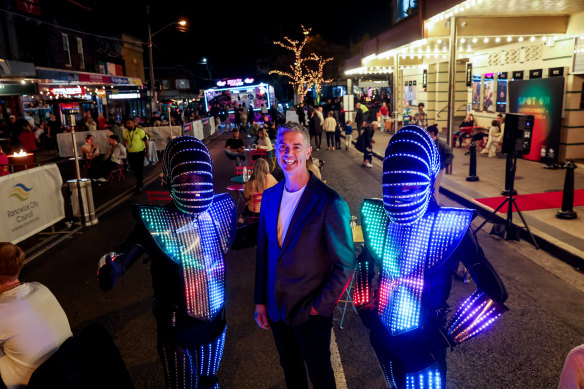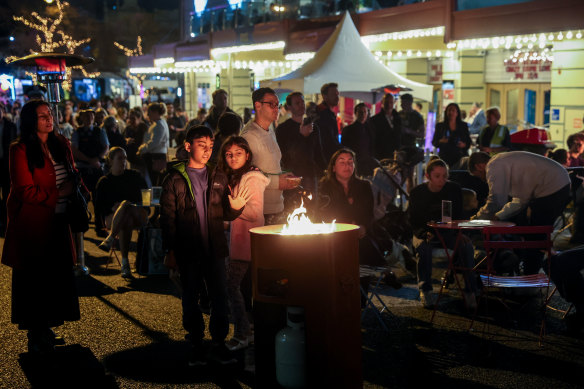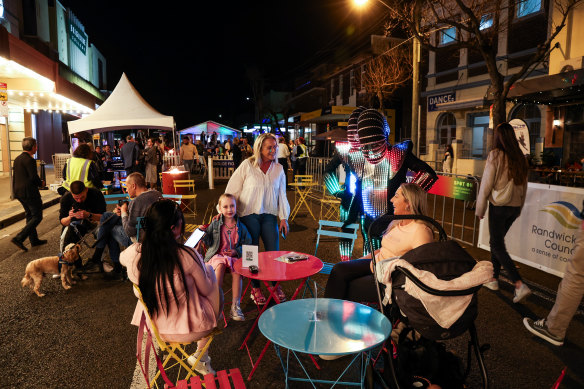This was published 7 months ago
Suburbs v CBD: Can the state government revitalise both?
Arts Minister John Graham might have ditched his business shirt and tie for Randwick Council’s Spot On Festival, but he still looked overdressed next to the two masked figures in neon-striped bodysuits.
The festival, which turned St Pauls Street in Randwick into a nighttime dining and entertainment precinct last month, is one of 130 free-entry events funded by the Minns government’s $8.7 million Open Streets program, designed to boost ailing local shopping precincts across Sydney and regional NSW.

Arts Minister John Graham at Randwick’s Spot On festival.Credit: Edwina Pickles
The investment aims to bolster local businesses buckling under the cost-of-living crisis.
Sixteen local councils, including Randwick, will also receive funding under an $8 million Permit/Plug/Play scheme to cut red tape for such events, Graham announced at the festival. Councils have complained about the up to $122,000 a day costs of shutting down streets for festivals, concerts and markets.
“The government would love to see more of these open street events but lots of local councils have said it’s just too expensive,” Graham said at the festival.
During the pandemic, many Sydneysiders rediscovered hanging out in their own suburbs, with local cafes and restaurants experiencing a surge in bookings, particularly at lunchtime, as the city embraced working from home.
But the tide has turned away from remote work, and Premier Chris Minns has now called for public servants to return to work in their offices to boost ailing CBDs. So, can the state government save local high streets, and return workers to the office five days a week?
Graham said government efforts to boost suburban shopping precincts was not at odds with “encouraging” workers back into the office.
“We can have vibrant local main streets and thriving central business districts, but both need to evolve,” he said. “Local main streets need more flexible use and CBDs need to reinvent themselves to give people reasons to go there.”
Committee for Sydney mobility policy manager Harri Bancroft said hybrid work arrangements were good for businesses across the city as well as people’s well-being and happiness.

The Spot On Festival in Randwick.Credit: Edwina Pickles
“We need to be thinking about the buzz, not just of Sydney’s major centres, but also local centres,” she said.
On an average weekday, Sydneysiders were commuting less but making more than half a million additional trips for social and recreational purposes, compared to pre-COVID times, Bancroft said.
“What we’ve seen with hybrid work is a reduction in the amount of time people spend commuting, which opened up more time to do fun things,” she said.
KPMG urban economist Terry Rawnsley said housing development, local amenity and socio-economic factors had a far greater impact on local businesses than any shift away from working at home.

The Spot On festival turned St Pauls Street in Randwick into a nighttime dining and entertainment precinct.Credit: Edwina Pickles
In Randwick’s case, Rawnsley said the area’s population had declined by about 1000 people, or four per cent, since 2019.
“This demographic change would likely have a more significant impact on local businesses than any alterations in work-from-home practices over the past year,” he said.
Randwick Mayor Philipa Veitch said the Spot On festival, which will be held every Thursday night until October 24, provided a place for staff coming off shift at nearby hospitals to grab a meal and listen to live music, while also supporting local musicians and performers.
“It’s a win-win for local workers and businesses, residents and performers, and we expect there’ll be demand for more,” she said.
The street festival is backed by Randwick and Spot Chambers of Commerce chairwoman Janet Alexander, who said it fostered a sense of community between residents and business owners.
“Local businesses are having problems with costs of living and rents that they pay,” she said. “The property owners are not supporting business in lowering rents. This makes it difficult in this economic climate.”
Veitch said local shopping strips were affected by land banking and steep rent hikes, “and small businesses are effectively becoming locked out of these key retail strips”.
“The result is more vacant shops and a decline in visitors,” she said.

The government is spending millions on local street parties and festivals.Credit: Edwina Pickles
But Business Sydney executive director Paul Nicolaou said suburban retail trips were poorly managed by local councils.
“Despite the efforts that go into planning, maintaining and marketing local shopping strips, the people who use these places are often not consulted about what they want and need on their main street,” he said.
Other councils to receive funding under the Permit/Plug/Play scheme include Canada Bay, which will use the funding for electricity and water along Rodd Road in Five Dock for the Italian Street Festival and Burwood, which will establish traffic management arrangements for its Burwood Road street party.
The Morning Edition newsletter is our guide to the day’s most important and interesting stories, analysis and insights. Sign up here.